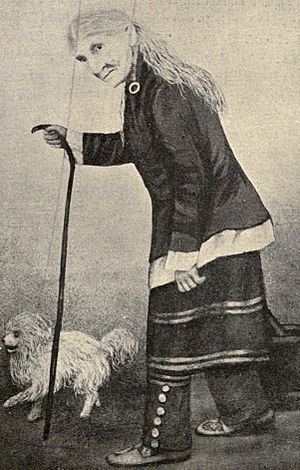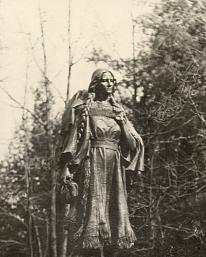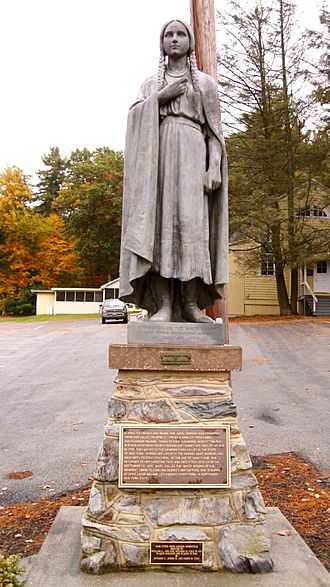Mary Jemison facts for kids
Quick facts for kids
Mary Jemison
|
|
|---|---|

Illustration, from an 1892 account of missionary activity in upstate New York
|
|
| Born |
Mary Jemison
1743 At sea on the Atlantic Ocean
|
| Died | September 19, 1833 (aged 89–90) |
| Other names | Dehgewänis |
| Known for | adopted Seneca and for her memoir |
Mary Jemison (also known as Deh-he-wä-nis) was born in 1743 and passed away on September 19, 1833. She was a Scots-Irish woman who lived on the frontier in Pennsylvania and New York. People knew her as the "White Woman of the Genesee."
When she was a young girl, Native Americans captured her. She was then adopted into a Seneca family. Mary learned their ways, married two Native American men, and had children with them. In 1824, she shared her life story in a book. This type of book is called a captivity narrative.
During the French and Indian War in 1755, Mary was 12 years old. She was captured with most of her family by Shawnee warriors in Pennsylvania. Her other family members were killed. Mary and another young boy were adopted by Seneca families. She fully became part of their culture.
Mary chose to stay with the Seneca people. She did not return to the American colonial way of life. Later in her life, she told her story to a minister. He wrote it down and published it as Narrative of the Life of Mrs. Mary Jemison in 1824. In 1874, her remains were moved to a special place near a Seneca council house. This place is now Letchworth State Park.
Contents
Mary Jemison's Early Life
Mary Jemison was born on a ship called William and Mary in 1743. Her parents, Thomas and Jane Jemison, were traveling from Ireland to America. They landed in Philadelphia, Pennsylvania.
Her family, like many other Scots-Irish immigrants, moved west. They wanted to settle on cheaper land in the backcountry of Pennsylvania. This land was bought by the Penn family from the Iroquois Confederacy. The Iroquois were six powerful Native American nations in New York.
The Jemisons started a farm and had several children. By 1755, the French and Indian War had begun. This war was part of a bigger conflict between France and Britain. Both sides had Native American allies.
Captured by Warriors
One morning in 1755, a group of six Shawnee warriors and four Frenchmen attacked. They captured Mary, her family (except two older brothers), and a young boy. On their way to Fort Duquesne (now Pittsburgh), the Shawnee killed Mary's mother, father, and siblings.
Mary later learned about a Seneca custom. If one of their people was killed in battle, they would take an enemy prisoner. This was part of a mourning ritual. Two Seneca women had lost a brother in the war a year before Mary's capture. The Shawnee captured Mary to give to these women.
Mary, at 12 years old, and the young boy were spared. They were the right age for adoption. At Fort Duquesne, Mary was given to the two Seneca women. They took her to their village. After a short ceremony, a Seneca family adopted Mary. They gave her the name Deh-he-wä-nis. This name meant "a pretty girl" or "a good thing."
Life with the Seneca
When Mary grew up, she married a Delaware man named Sheninjee. He lived with the Seneca group. They had a son, whom Mary named Thomas after her father. Sheninjee took Mary and their son on a long journey. They traveled about 700 miles to the Sehgahunda Valley in present-day Western New York.
Mary and her son reached their new home, but Sheninjee did not. He became sick while hunting and died. As a widow, Mary and her child were welcomed by Sheninjee's relatives. She made her home at Little Beard's Town.
Mary married again, this time to a Seneca man named Hiakatoo. They had six children together: Nancy, Polly, Betsey, Jane, John, and Jesse.
During the American Revolutionary War, the Seneca people sided with the British. They hoped a British victory would help them keep their lands from the colonists. Mary's stories include details from this time. She and others in her Seneca town helped Joseph Brant and his Iroquois warriors. These warriors fought against the American colonists.
After the war, the British gave their lands east of the Mississippi River to the United States. They did not talk to their Native American allies first. The Seneca were forced to give up their lands to the United States. In 1797, the Seneca sold much of their land at Little Beard's Town.
During these land talks, Mary Jemison was a skilled negotiator for the Seneca tribe. She helped them get better terms for giving up their land. This happened at the Treaty of Big Tree in 1797.
Late in her life, Mary told her story to a minister named James E. Seaver. He wrote it down and published it as Narrative of the Life of Mrs. Mary Jemison in 1824. This book is a famous example of a captivity narrative.
Some early readers thought Seaver might have changed her story. But since the late 1900s, many historians believe it is a true account. Mary's story shows that she preferred living with the Seneca. She liked it more than the life she had seen among colonial British women.
In 1823, the Seneca sold most of their remaining land in that area. However, they saved a small piece of land, about 2 acres, just for Mary. Local European-American people knew her as the "White Woman of the Genesee." Mary lived on this land for several years. In 1831, she sold it and moved to the Buffalo Creek Reservation. Some Seneca people lived there.
Mary Jemison passed away on September 19, 1833, at 90 years old. She was first buried on the Buffalo Creek Reservation. Mary's descendants later changed their last name to "Jimerson." They created the community of Jimersontown on the Allegany Indian Reservation.
Mary's Account of Her Capture
Mary Jemison shared details about her capture. She said the group that took them had six Native Americans and four Frenchmen. They immediately started taking things they thought were valuable. These included bread, meal, and meat.
After taking enough food, they left quickly with their prisoners. They were afraid of being found. Soon, they entered the woods. On their journey that day, a Native American walked behind them with a whip. He used it to make the children keep up.
They traveled until dark without food or water. They had not eaten since the night before. When the little children cried for water, the Native Americans made them go thirsty. At night, they camped in the woods without fire or shelter. They were watched very closely. They were tired and hungry. They had to lie on the ground without supper or water.
Mary said that only tiredness brought them a little sleep. At dawn, they started walking again in the same way. Around sunrise, they stopped. The Native Americans gave them a full breakfast from the food they took from Mary's father's house. Everyone was very hungry and ate, except her father. He was so sad and worried that he could not eat.
After they finished eating, they started walking again. Before noon, they passed a small fort. Mary heard her father say it was called Fort Canagojigge. That was the only time she heard him speak from their capture until they were separated.
Toward evening, they reached a dark swamp. It was covered with small evergreen trees and bushes. They were led into it. After a short distance, they stopped to camp for the night. Here, they had some bread and meat for supper. But their sad situation and not knowing what would happen next made them lose their hunger.
As soon as Mary finished her supper, a Native American took off her shoes and stockings. He put a pair of moccasins on her feet. Her mother saw this. She believed they would spare Mary's life, even if they harmed the others. Mary remembered her mother saying:
"My dear little Mary, I fear we must be separated forever. Your life, my child, I think will be saved. But we will probably be harmed here in this lonely place by the Native Americans. Oh! how can I part with you, my darling? What will happen to my sweet little Mary? Oh! how can I think of you staying in captivity, with no hope of being rescued? Oh! I wish death had taken you when you were a baby. The pain of parting then would have been easier than it is now. And I would have seen the end of your troubles! Alas, my dear! my heart hurts thinking about what awaits you. But, if you leave us, remember, my child, your own name, and the names of your father and mother. Be careful and do not forget your English language. If you have a chance to get away from the Native Americans, do not try to escape. If you do, they will find and harm you. Do not forget, my little daughter, the prayers I taught you. Say them often. Be a good child, and God will bless you! May God bless you, my child, and make you comfortable and happy."
While this happened, the Native Americans took the shoes and stockings from the little boy who was captured with them. They put moccasins on his feet, just like they did for Mary. Mary was crying. A Native American took the little boy and Mary by the hand. He led them away from the group. Mary's mother called out, "Don't cry, Mary! Don't cry, my child! God will bless you! Farewell! Farewell!"
The Native American led them some distance into the bushes. There, he lay down with them to spend the night. Mary could not sleep because she kept thinking about leaving her mother. Tears kept flowing from her eyes. Many times that night, the little boy begged her to run away with him. But Mary remembered her mother's advice. She knew the dangers of traveling without a path or guide in an unknown wilderness. She told him she would not go and convinced him to stay still until morning.
Legacy and Honors
In 1874, Mary Jemison's family asked for her remains to be moved. She was reburied near the 1765 Seneca Council House. This building had been moved by William Pryor Letchworth to his Glen Iris Estate. John Shanks, one of Mary's Seneca grandsons, helped restore the building in 1872.
Letchworth invited Seneca and state officials to a special event for the Council House. In 1881, Letchworth also bought a cabin that belonged to Mary's daughter, Nancy Jemison. He moved it near the Council House and Mary's grave. In 1906, he gave his entire estate to New York State. Today, this property is part of Letchworth State Park.
A bronze statue of Mary Jemison marks her grave. Henry Kirke Bush-Brown created it in 1910. After the park grounds were restored, the statue was placed between the council house and the cabin in 2006. Dr. George Frederick Kunz helped pay for and order the 1910 statue.
In Popular Culture
- Indian Captive: The Story of Mary Jemison (1941) is a fictional book about Mary Jemison. It was written and illustrated by Lois Lenski. In this novel, Mary is called "Little Woman of Great Courage." This name comes from her choice to live as a Native American woman. Before, her name in the book was Corn Tassel because her hair was the color of corn tassels.
- Rayna M. Gangi's novel, Mary Jemison: White Woman of the Seneca (1996), is another fictional story about Mary Jemison.
- Deborah Larsen's novel, The White (2002), is a fictional version of Mary Jemison's life. It imagines how she became part of the Seneca culture.
- Jeanne LeMonnier Gardner's book, "Mary Jemison: Indian Captive" (1966), is a fictional story for children.
See also
- Herman Lehmann
- Olive Oatman
- Mary Ann Oatman
- Frances Slocum




